Cobalt delivers higher energy density and stability in lithium-ion batteries, while manganese offers increased thermal stability and cost-effectiveness. Balancing cobalt's performance with manganese's affordability enhances battery safety and lifespan.
Table of Comparison
| Property | Cobalt (Co) | Manganese (Mn) |
|---|---|---|
| Atomic Number | 27 | 25 |
| Density (g/cm3) | 8.90 | 7.43 |
| Electrochemical Role in Battery | Stabilizes cathode structure, enhances energy density | Improves thermal stability, increases cycle life |
| Common Battery Types | Li-ion (NMC, NCA) | Li-ion (LMO, NMC) |
| Cost | High due to scarcity and ethical sourcing issues | Lower and more abundant |
| Toxicity & Environmental Impact | Higher toxicity, complex recycling | Lower toxicity, easier recycling |
Introduction to Cobalt and Manganese in Battery Technology
Cobalt and manganese are critical transition metals utilized in lithium-ion battery cathodes for enhancing energy density and stability. Cobalt improves battery lifespan and thermal stability due to its ability to stabilize the cathode structure, while manganese offers cost-effectiveness and environmental benefits with high structural stability and safety. Battery manufacturers balance cobalt's high performance and supply chain risks with manganese's availability and ecological advantages to optimize battery technology for electric vehicles and energy storage systems.
Chemical Properties: Cobalt vs Manganese
Cobalt exhibits a stable +3 oxidation state and superior electronic conductivity, enhancing battery cathode material performance, while manganese primarily exists in the +4 and +3 oxidation states, contributing to structural stability and safety in lithium-ion batteries. The higher redox potential of cobalt enables increased energy density, whereas manganese's abundant availability and lower cost support sustainable battery production. Both elements influence battery lifespan and efficiency through their distinct electrochemical behaviors in cathode chemistries such as NMC (Nickel Manganese Cobalt) and LMO (Lithium Manganese Oxide).
Role of Cobalt and Manganese in Battery Performance
Cobalt enhances battery performance by stabilizing the cathode structure and improving energy density, leading to longer cycle life and higher capacity retention in lithium-ion batteries. Manganese contributes to battery stability by providing structural support and boosting thermal stability, which helps prevent overheating and degradation during fast charging. The combination of cobalt and manganese in cathode materials like NMC (Nickel Manganese Cobalt) balances energy density, safety, and lifespan for optimized battery performance.
Energy Density Comparison
Cobalt batteries typically offer higher energy density compared to manganese-based batteries, making them more suitable for applications requiring extended battery life and compact size. Manganese batteries provide lower energy density but excel in thermal stability and cost-effectiveness, which benefits safety and affordability. The trade-off between cobalt's superior energy density and manganese's enhanced safety is crucial in selecting battery chemistry for electric vehicles and portable electronics.
Cost and Availability of Cobalt and Manganese
Cobalt is significantly more expensive than manganese, with cobalt prices often exceeding $50,000 per metric ton compared to manganese's cost of around $2,000 per metric ton, impacting overall battery production expenses. Availability of cobalt is limited and geographically concentrated, primarily in the Democratic Republic of Congo, which poses supply chain risks and price volatility. Manganese is more abundant globally, notably in countries like South Africa and Australia, offering a more stable and cost-effective raw material source for battery manufacturers.
Environmental Impact and Sustainability
Cobalt mining presents significant environmental challenges, including habitat destruction, toxic waste, and high energy consumption, which raise concerns about long-term sustainability in battery production. Manganese offers a more abundant and less environmentally damaging alternative, with lower toxicity and a smaller ecological footprint during extraction and processing. The shift towards manganese-based battery chemistries promotes sustainable resource use and reduces reliance on conflict-linked cobalt, supporting greener energy storage solutions.
Safety Considerations in Cobalt and Manganese Batteries
Cobalt-based batteries offer high energy density but pose safety risks due to thermal instability and potential toxicity during mechanical abuse or overheating. Manganese batteries provide enhanced thermal stability and lower toxicity, reducing the likelihood of thermal runaway and improving overall safety in energy storage applications. Selecting manganese over cobalt can enhance battery safety while maintaining competitive performance in electric vehicles and portable electronics.
Industry Trends and Market Demand
Cobalt remains a critical component in lithium-ion batteries due to its stability and energy density, but rising costs and ethical concerns drive manufacturers to seek lower-cobalt alternatives. Manganese is gaining traction as a cost-effective and abundant substitute, especially in lithium-manganese spinel and nickel-manganese-cobalt (NMC) chemistries, supporting higher performance and sustainability goals. Market demand is shifting toward manganese-enriched cathodes, reflecting industry trends prioritizing raw material sourcing, battery safety, and reduced dependency on cobalt imports.
Innovations in Battery Chemistry: Blends and Alternatives
Innovations in battery chemistry increasingly explore cobalt-manganese blends to balance energy density and cost while improving thermal stability. Research into manganese-rich cathodes reduces cobalt dependence by leveraging manganese's abundance and environmental benefits, enhancing battery sustainability. Emerging alternatives focus on optimized cathode formulations combining cobalt's capacity retention with manganese's structural stability to extend battery lifespan and performance.
Future Outlook: Cobalt vs Manganese in Next-Gen Batteries
Cobalt remains crucial for enhancing energy density and stability in next-gen lithium-ion batteries, but its supply constraints and ethical concerns drive the search for manganese alternatives. Manganese offers a cost-effective, abundant, and environmentally friendly option, particularly in high-nickel cathode formulations aiming to reduce cobalt dependency. Future battery technologies increasingly prioritize manganese to balance performance, sustainability, and scalability in electric vehicle and grid storage applications.

Infographic: Cobalt vs Manganese for Battery
 azmater.com
azmater.com